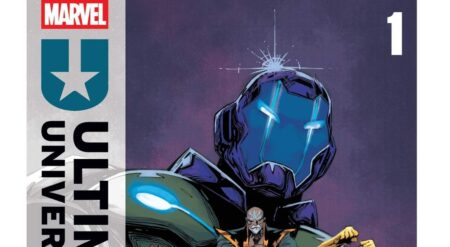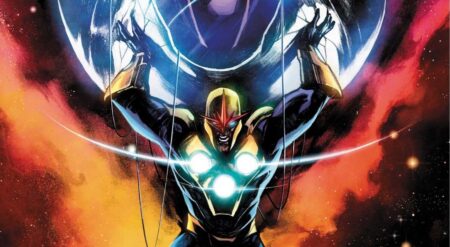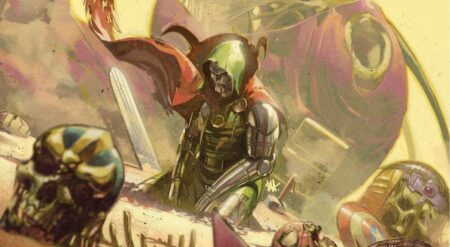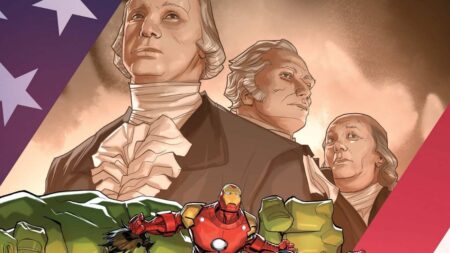Fantastic Four: Marvels Snapshot is published by Marvel Comics, written by Evan Dorkin, and Sarah Dyer, art by Benjamin Dewey, colors by Jordie Bellaire, and letters by VC’s Joe Caramagna. The Snapshot series focuses the spotlight on a different Marvel character from their time in the golden years of comics throughout each issue. The perspective we’re shown, however, is not through the eyes of the hero, but rather, an ordinary person who’s happened to share some time with the individual.
We join the story as a newscaster informs us that the Avengers and the Government are not communicating with the public after the Red Skull unleashes a deadly biological weapon from Mount Rushmore, the ‘Red Zone’ attack. Several other Marvel Comics plots are read aloud over the news to give you a sense of when this issue takes place.
Meanwhile, a woman is getting ready in her bedroom as the audio shifts to announcing that Johnny Storm is set to appear in his hometown, Glenville, Long Island tonight for his 10-year High School anniversary. Insert copious amounts of fire-related jokes, that you just know would be made on national television if a superhero did exist.
The woman, Doris Evans, Johnny Blazes’ High School Sweetheart, is also preparing to speak to the local news about recording a segment showcasing her memories and experiences of knowing the Human Torch and the Invisible Woman in the early days, pre and post super-powered abilities. Given Sue Storm was a little older when she got her powers, the issue focuses less on her contributions to Glenville as she’d already the town by then. There is some time spent on the exposition of this idea, as the author wants to relay the message that while not discounting the impacts of Sue, there’s just more to talk about when it comes to Johnny living in his hometown.
During the subsequent events of the reunion, Johnny arrives, and frankly, he acts like a huge, entitled, spoiled jerk. Something is amiss though, as some of the residents really lay into him, while his other supposed friends hang back, and don’t attempt to approach him. This all catches the eye of report Marcia Hardesty, as she smells a story.
If you are a fan of the golden age of comics, in style, and/or storytelling, then this will tick a lot of boxes for you. If you’re looking for an action-packed, edge-of-your-seat issue, then this may not be your cup of tea. Dorkin, and Dyer, find an interesting angle to take with this story, as they build up the mythos of Johnny Storm, both from a positive aspect to the negatives. The pace is a lot slower, and it does continue this way from the beginning through to the end, however, the authors aren’t trying to have the story explode in your face. This is meant to be an exposé from the experiences of those around Johnny, as Dorkin and Dyer attempt to show what life was like for those who grew up around the Human Torch, and what they made of those experiences.
Dewey, and Bellaire have some really fantastic, yes that was intentional, contributions in this issue with their art and colors, as there are so many easter eggs from the golden ages of comics buried throughout the panels. When Doris first comes down into her living room her children are playing with toys of characters that will have fans smiling as features numerous Marvel cameos. Not to mention, the issue is drawn entirely in the style of the golden age of comics, that one can read from the 40s, 50s and 60s. Visually, it was fun to take a break and look back over how comics were drawn, in what feels like a love letter to the origins of the industry. The coloring especially indicates this and is notable during certain flashback scenes when the style of the colors has a textured feel that is reminiscent of the time period.
The lettering of Caramagna is spot on, as the experienced comics contributor balances the dialogue well without it distracting from the images. There is a lot to balance here also; given the lack of action sequences, Caramagna had to get creative. One particular panel really stole my gaze, as early on in pages eight and nine, we’re treated to the introduction of the classic animated show Fantastic Four with the timeless font style and colors.
Overall, this was a fun issue to read and somewhat thought-provoking given the variety of perspectives Dorkin and Dyer chose to go with. Fantastic Four: Marvels’ Snapshot won’t be for everyone, as the pace can feel somewhat labored, and the story lacking in action. For others, however, I think this will be a great break from the norm and a flashback into the golden era of comics.
Fantastic Four: Marvels’ Snapshot is available in comic book stores now.
Fantastic Four: Marvels Snapshot
TL;DR
Overall, this was a fun issue to read, and somewhat thought provoking given the choice of perspectives Dorkin and Dyer chose to go with. Fantastic Four: Marvels Snapshot won’t be for everyone, as the pace can feel somewhat labored, and the story lacking in action. For others however, I think this will be a great break from the norm and a flashback into the golden era of comics.








